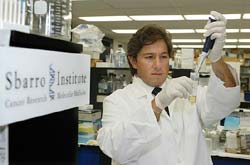Temple study identifies molecular mechanisms that may assist gene in blocking lung cancer

Dr Antonio Giordano, director of the Sbarro Institute for Cancer Research and Molecular Medicine based at Temple University. <br>Photo Credit: Joseph V. Labolito
The molecular mechanisms that may assist the tumor suppressing gene Rb2/p130 in blocking the progression of lung cancer cells has been clearly identified for the first time according to a study by researchers at Temple University’s Sbarro Institute for Cancer Research and Molecular Medicine.
The results of their study, “pRb2/p130 target genes in non-small cell lung cancer cells identified by microarray analysis,” appear in the Oct. 9 issue of Oncogene (http://www.nature.com/onc/).
The study, led by Antonio Giordano, M.D., Ph.D., head of the Sbarro Institute at Temple, was a follow-up to previous experiments led by Giordano that demonstrated an inverse relationship between Rb2 expression and the aggressiveness of lung cancer. Giordano discovered the Rb2 gene while working at Temple’s Fels Cancer Institute in the early 1990s. In those earlier studies, correct copies of Rb2 were introduced into mice with lung tumors using a viral system developed by Pier Paolo Claudio, M.D., Ph.D., associate professor of biotechnology at the Sbarro Institute. When the Rb2 gene was over-expressed in the cancer cells, it caused the tumors in the mice to completely regress(http://jncicancerspectrum.oupjournals.org/jnci/content/vol90/issue19).
“In this study, we wanted to understand the molecular mechanisms behind Rb2/p130 tumor growth inhibition,” says Giuseppe Russo, Ph.D., a post doctoral fellow at the Sbarro Institute and the study’s lead author. “We wanted to know what this gene does in lung cancer cells, what other genes it may target, and how it controls cell regulation.
“It’s like this molecular process of tumor regression is a movie and Rb2 is the lead actor,” Giordano adds. “What we wanted to know is who the supporting cast is.”
After introducing correct copies of Rb2 into H23 lung cancer cells via Claudio’s viral shuttle, the researchers used customized microarray analysis to examine the simultaneous expression of thousands of genes within the cancer cell. Microarray is a powerful new tool that allows researchers to study the molecular basis of interactions on a scale that had been impossible using conventional methods.
“Through the use of the microarray, we were able to see which genes were over-expressed or under-expressed because of the enhanced Rb2 gene expression,” says Giordano. “This is the first time that we have been able to clearly identify the genes that were being regulated by the Rb2 expression in lung cancer cells.”
Some of the nearly 70 regulated genes that were identified through this study were previously known to be involved in the progression of lung cancer, says Giordano, meaning that the researchers were able to confirm previously published data. “But many of the identified genes were not previously known to be involved in lung cancer or be regulated by Rb2,” he adds. The Temple researchers believe that identifying these genes could play an important role in developing future gene therapies to diagnose and treat lung cancer.
“Any regulation in a gene that is found to be caused by Rb2 is important to us because we can then study why that gene is regulated and use that information to develop molecular therapeutic approaches to lung cancer,” says Giordano. “The gene expression profiles provided by microarray analysis will someday help tailor specific gene therapies to individual patients.” Lung cancer is the leading cause of cancer death worldwide and is usually diagnosed at an incurable stage, most likely due to the absence of effective therapies as well as standard diagnostic procedures of early tumoral stages when compared with other cancers types, such as colon, breast and prostate cancers.
The study was funded by the National Institutes of Health and the Sbarro Health Research Organization.
Media Contact
All latest news from the category: Life Sciences and Chemistry
Articles and reports from the Life Sciences and chemistry area deal with applied and basic research into modern biology, chemistry and human medicine.
Valuable information can be found on a range of life sciences fields including bacteriology, biochemistry, bionics, bioinformatics, biophysics, biotechnology, genetics, geobotany, human biology, marine biology, microbiology, molecular biology, cellular biology, zoology, bioinorganic chemistry, microchemistry and environmental chemistry.
Newest articles

Long-sought structure of powerful anticancer natural product
…solved by integrated approach. A collaborative effort by the research groups of Professor Haruhiko Fuwa from Chuo University and Professor Masashi Tsuda from Kochi University has culminated in the structure…

Making a difference: Efficient water harvesting from air possible
Copolymer solution uses water-loving differential to induce desorption at lower temperatures. Harvesting water from the air and decreasing humidity are crucial to realizing a more comfortable life for humanity. Water-adsorption…

In major materials breakthrough
UVA team solves a nearly 200-year-old challenge in polymers. UVA researchers defy materials science rules with molecules that release stored length to decouple stiffness and stretchability. Researchers at the University…



